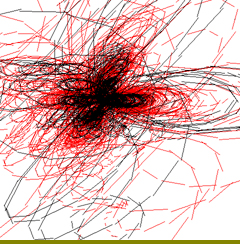
larger GIF
larger TIF
Abstract:
This work consists of 24 Java-based drawing programs, each constructed and used by the author to create specific series of drawings. I define the "computational line" as a sophisticated drawing element controlled by various parameters of a gesture, such as speed, direction, position or order. The work questions the act of drawing in the computational medium and presents a different creative model for visual composition, one that is more iterative and evaluative. Compositions combine higher level conceptual design with real-time gestural drawing. Computational drawing is a two-fold process, at two distinct levels of interaction with the computer. The artist must program the appearance and behavior of computational lines and then draw with these by dragging a mouse or controlling another input device. The resulting aesthetic highlights the tension between repetition and variation, regularity and irregularity, mathematical order and gestural disorder.
In this talk, I will discuss my Masters research, show several of the original drawing tools, introduce a new Computational Drawing system that I am developing, and, if time permits, show some work by John Maeda (Aesthetics and Computation group at the MIT Media Lab), which has inspired me.
Full text:
Computers have introduced new concepts into the artist's vocabulary, concepts such as interactivity, dynamism and emergence that shape the development of new forms of visual expression. In particular, the computational medium suggests a new approach to the act of drawing. Instead of duplicating the methods and materials we know from traditional media, we seek to develop a different perspective on visual thinking, one that involves a more active participation in the higher level design of drawing tools. The work consists of 24 Java-based drawing programs, each constructed and used by the author to create specific series of drawings. We define the "computational line" as a sophisticated drawing element controlled by various parameters of a gesture, such as speed, direction, position or order. Complex shapes can be created with very simple gestures. A computational line has three attributes: (1) physical appearance (a shape, a pattern, a representation of a mathematical algorithm or a color), (2) individual behavior or dynamism, some transformation over time (a shift in color, position, shape, or other attribute) (3) and behavior in its interaction with the other lines on the canvas. The line can sense the presence, proximity and topology of others, and respond in pre-determined but unpredictable ways.
Computational Expressionism presents a model for drawing that combines higher level conceptual design with real-time gestural input. It is a two-fold process, at two distinct levels of interaction with the computer. The artist programs the appearance and behavior of computational lines and then draws with these by dragging a mouse or controlling another input device. The process of computational sketching consists of writing the code, compiling the program, running it and making some sketches on the digital canvas. The drawings thus produced instruct the next iteration of the code, the algorithms are refined and varied. The iterative bipartite process of programming and drawing generates an individualized algorithmic style for a particular drawing.
The computer differs from other media in that it is both a constructive and a projective medium. Computation invites us to represent, but also to interpret the world around us, through experimentation and abstraction. In this work, the artist develops individual interpretations of the meaning of gestures and constructs tools to represent them in the final composition. This conceptual interpretation of gestures is a very personal part of the process, and a key element of the model of drawing with computation.
Because computational lines are no longer literal representations of a gesture, the aesthetic qualities of an algorithm or of a dynamic interaction generally outweigh representational potential. Thus our work in computational drawing has been almost exclusively non-representational. The quality of lines is a strong aesthetic theme, together with the expressive potential of gesture, and the textures and tones achieved through a layering of lines. The compositions emerge from the interaction between the algorithms and behaviors of the computational lines and the gestures used in drawing. The resulting aesthetic takes advantage of the medium's unique characteristics (interactivity, dynamism and emergence) and highlights the tension between repetition and variation, regularity and irregularity, mathematical order and gestural disorder.



